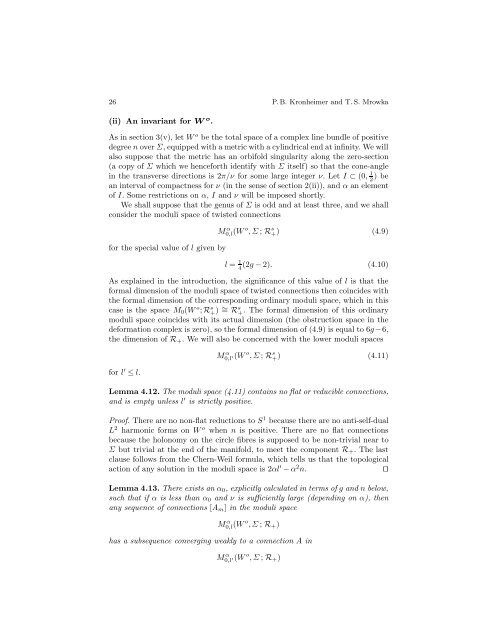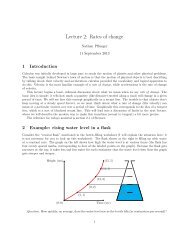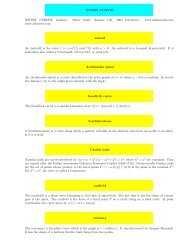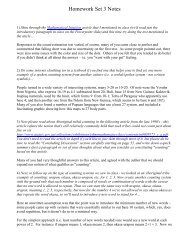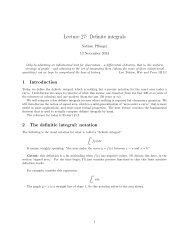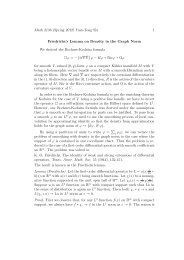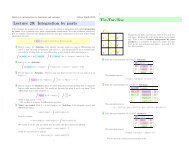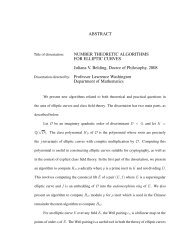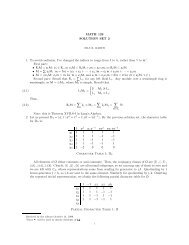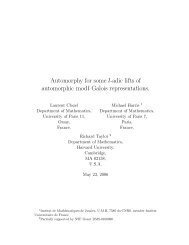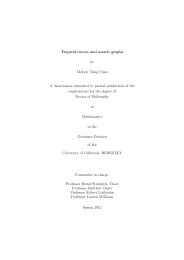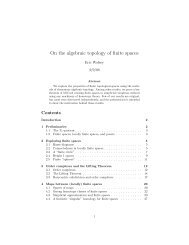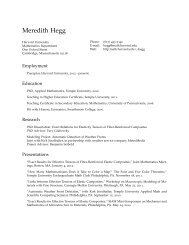Gauge theory for embedded surfaces, II
Gauge theory for embedded surfaces, II
Gauge theory for embedded surfaces, II
You also want an ePaper? Increase the reach of your titles
YUMPU automatically turns print PDFs into web optimized ePapers that Google loves.
26 P. B. Kronheimer and T. S. Mrowka<br />
(ii) An invariant <strong>for</strong> W o .<br />
As in section 3(v), let W o be the total space of a complex line bundle of positive<br />
degree n over Σ, equipped with a metric with a cylindrical end at infinity. We will<br />
also suppose that the metric has an orbifold singularity along the zero-section<br />
(a copy of Σ which we hence<strong>for</strong>th identify with Σ itself) so that the cone-angle<br />
in the transverse directions is 2π/ν <strong>for</strong> some large integer ν. Let I ⊂ (0, 1<br />
2 )be<br />
an interval of compactness <strong>for</strong> ν (in the sense of section 2(ii)), and α an element<br />
of I. Some restrictions on α, I and ν will be imposed shortly.<br />
We shall suppose that the genus of Σ is odd and at least three, and we shall<br />
consider the moduli space of twisted connections<br />
<strong>for</strong> the special value of l given by<br />
M α 0,l(W o ,Σ; R s +) (4.9)<br />
l = 1<br />
4 (2g − 2). (4.10)<br />
As explained in the introduction, the significance of this value of l is that the<br />
<strong>for</strong>mal dimension of the moduli space of twisted connections then coincides with<br />
the <strong>for</strong>mal dimension of the corresponding ordinary moduli space, which in this<br />
case is the space M0(W o ; R s + ) ∼ = R s +<br />
. The <strong>for</strong>mal dimension of this ordinary<br />
moduli space coincides with its actual dimension (the obstruction space in the<br />
de<strong>for</strong>mation complex is zero), so the <strong>for</strong>mal dimension of (4.9) is equal to 6g −6,<br />
the dimension of R+. We will also be concerned with the lower moduli spaces<br />
<strong>for</strong> l ′ ≤ l.<br />
M α 0,l ′(W o ,Σ; R s + ) (4.11)<br />
Lemma 4.12. The moduli space (4.11) contains no flat or reducible connections,<br />
and is empty unless l ′ is strictly positive.<br />
Proof. There are no non-flat reductions to S 1 because there are no anti-self-dual<br />
L 2 harmonic <strong>for</strong>ms on W o when n is positive. There are no flat connections<br />
because the holonomy on the circle fibres is supposed to be non-trivial near to<br />
Σ but trivial at the end of the manifold, to meet the component R+. The last<br />
clause follows from the Chern-Weil <strong>for</strong>mula, which tells us that the topological<br />
action of any solution in the moduli space is 2αl ′ − α 2 n. ⊓⊔<br />
Lemma 4.13. There exists an α0, explicitly calculated in terms of g and n below,<br />
such that if α is less than α0 and ν is sufficiently large (depending on α), then<br />
any sequence of connections [Am] in the moduli space<br />
M α 0,l (W o ,Σ; R+)<br />
has a subsequence converging weakly to a connection A in<br />
M α 0,l ′(W o ,Σ; R+)


